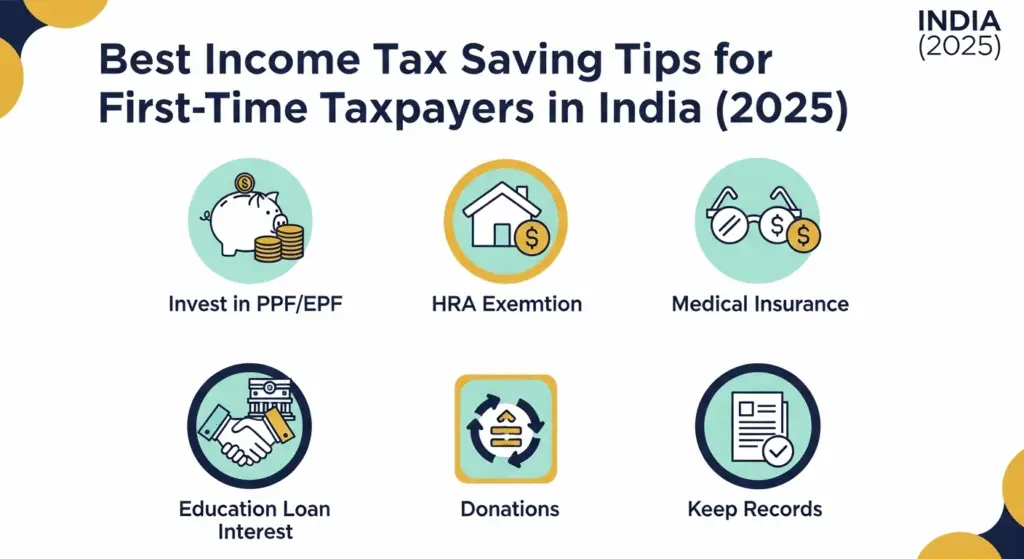
Paying income tax for the first time can feel overwhelming, especially when you’re just starting your career or business. But here’s the good news: the Indian government provides several legal ways to reduce your tax liability and save more of your hard-earned money.
In this guide, we’ll explain the best income tax saving tips for first-time taxpayers in India — in simple, clear language — so you can make smart financial decisions and avoid overpaying taxes.
💼 Who Is Considered a First-Time Taxpayer?
If you’re:
- Earning a salary for the first time,
- Running a new business or freelancing,
- Or earning income above the basic exemption limit (₹2.5 lakh for FY 2024-25 under old regime),
…then you’re likely required to file an Income Tax Return (ITR).
💡 1. Choose the Right Tax Regime
As of 2025, India offers two tax regimes:
A. Old Tax Regime
- Comes with various deductions and exemptions like 80C, HRA, etc.
- Better for people who make tax-saving investments.
B. New Tax Regime (Default)
- Lower tax slabs but no major deductions allowed.
- Best for those with fewer investments or deductions.
👉 Tip: Use online tax calculators to compare both and choose what suits your financial habits.
💰 2. Invest Under Section 80C (Up to ₹1.5 Lakh Deduction)
Section 80C is the most popular way to reduce your taxable income.
You can claim a deduction up to ₹1.5 lakh per year by investing in:
- Employee Provident Fund (EPF)
- Public Provident Fund (PPF)
- Equity Linked Saving Scheme (ELSS)
- 5-Year Tax-Saving Fixed Deposits
- National Savings Certificate (NSC)
- Life Insurance Premiums
- Sukanya Samriddhi Yojana (for girl child)
- Principal repayment on home loans
- Children’s tuition fees
👉 Example: If your income is ₹6,00,000 and you invest ₹1.5 lakh under 80C, your taxable income becomes ₹4.5 lakh.
🏥 3. Claim Health Insurance Premiums – Section 80D
You can save tax by buying health insurance for yourself and your family.
- Self/spouse/children: Up to ₹25,000
- Parents (senior citizens): Up to ₹50,000
- Total possible deduction: ₹75,000 per year
Even preventive health check-ups (within ₹5,000 limit) are covered.
🧓 4. Contribute to National Pension System (NPS) – Section 80CCD(1B)
Investing in NPS gives you an additional ₹50,000 deduction, over and above the ₹1.5 lakh limit under 80C.
This means:
- 80C = ₹1.5 lakh
- 80CCD(1B) = ₹50,000
- Total = ₹2 lakh tax deduction
NPS is ideal for building retirement wealth while reducing taxes.
🏠 5. Use Home Loan Benefits – Section 24(b)
If you have taken a home loan, you can claim:
- Interest paid on home loan: Up to ₹2 lakh under Section 24(b)
- Principal repayment: Covered under 80C (within ₹1.5 lakh limit)
Bonus: You also get stamp duty and registration fee deduction under 80C.
🎓 6. Deduction on Education Loan Interest – Section 80E
If you’re paying an education loan for yourself or your dependents:
- Entire interest paid is deductible
- No upper limit
- Available for up to 8 years
Great for students or young professionals repaying student loans.
🪙 7. Claim House Rent Allowance (HRA) If Living in Rented House
If you’re a salaried employee living in a rented house, you can claim HRA exemption under Section 10(13A).
To claim:
- You must receive HRA from your employer
- You must actually pay rent and keep rent receipts
No HRA in the new regime.
🧾 8. File Your Income Tax Return (ITR) on Time
Even if your income is below the taxable limit, it’s a good habit to file your ITR:
- Helps you claim refunds (like TDS deducted)
- Required for visa, loan, and credit card applications
- Helps build your financial credibility
👉 Due date for ITR filing (FY 2024-25) is 31st July 2025.
👨💻 9. Track TDS and Form 26AS
Sometimes your employer or bank deducts TDS (Tax Deducted at Source).
You can:
- Check your Form 26AS on the Income Tax portal
- Match TDS with your Form 16 or bank FD interest
- Claim refunds if extra TDS was deducted
👮♂️ 10. Avoid Cash Income & Keep Digital Records
To stay safe from scrutiny:
- Avoid large cash transactions
- Keep digital records of all tax-saving investments
- Link PAN with Aadhaar
- File returns honestly to avoid penalties
📝 Summary Table: Top Tax-Saving Options
| Section | Investment Type | Max Deduction |
|---|---|---|
| 80C | ELSS, PPF, FD, LIC, etc. | ₹1.5 lakh |
| 80CCD(1B) | NPS contribution | ₹50,000 |
| 80D | Health insurance | ₹75,000 |
| 24(b) | Home loan interest | ₹2 lakh |
| 80E | Education loan interest | No limit |
| 10(13A) | HRA (for salaried tenants) | Varies by city |
❓ FAQs for First-Time Taxpayers in India
🔹 Q1. I just started working. Do I need to pay tax?
If your annual income exceeds ₹2.5 lakh (old regime), you must file ITR and may need to pay tax.
🔹 Q2. Which is better – old or new tax regime?
It depends. Choose old regime if you have investments and deductions. Use new regime if your finances are simple.
🔹 Q3. Do I need a CA to file my taxes?
No. You can file your ITR online using the Income Tax e-Filing Portal or use platforms like ClearTax or TaxBuddy.
🔹 Q4. What happens if I miss the ITR deadline?
You may have to pay a late filing fee of up to ₹5,000 and may not be able to claim your refund.
📌 Final Thoughts: Save Smart, Stay Compliant
Tax planning isn’t just for the rich. Even if you’re earning your first salary or just started a business, using the right deductions can help you legally save thousands.
Start early, keep records, and invest wisely — because saving tax is earning more without working extra hours!
